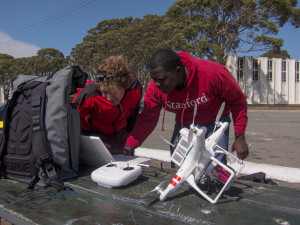On January 15, the Kenya Civil Aviation Authority issued a cease and desist order to individuals and entities operating unmanned aerial vehicles (popularly referred to as drones).
The ordinance advised that operators should seek permission from the Ministry of Defence to fly a drone; it was technically a ban. Not much reason was given that necessitated the order but there was enough to infer that the government was concerned about the health, safety and privacy challenges that may arise when operating drones.
The liberation of drone technology has spawned exciting use cases in the civic space. From farmers who survey their expansive farms to check on plant health, to emergency services that deploy drones as aerial scouts beaming important information to guide operations – all this at a fraction of the cost of using a helicopter.
In journalism, where my interest lies, the technology not only provides a low-cost alternative to aerial imaging, it also opens amazing possibilities in storytelling, for example producing 3D models, livecasting, data and sensor gathering and producing content for virtual reality platforms.
South Africa, unlike Kenya, chose a more informed and consultative route. It banned drones in June 2014, with the South African Civil Aviation Authority acknowledging their civic applications but also giving a convincing case for its concerns. But it went further: it promised to publish recommendations after a year, which it promptly did, and now South Africa is one of the world’s leaders in progressive drone lawmaking.
Sacca even went ahead to license a drone pilot school, which conducted a highly successful proof of concept project at the Hluhluwe iMfolozi Game Reserve in KwaZulu-Natal, resulting in a 92 percent drop in rhino poaching incidents. Contrast this with Kenya, which at the same time stopped a progressive drone project, Aerial Ranger, at Ol-Pejeta’s conservancy, a tool meant to help in the anti-poaching war and also provide e-tourism products, again citing security. Flying Donkey, another futuristic project proposing Amazon type delivery drones but on a much bigger scale, was also caught up in the predictable web of security concerns. Uganda and Morocco have also adopted the copycat reaction of banning drones.
I have been running African skyCAM, the continent’s first drone journalism project, for close to three years now. The project, a winner of the African News Innovation Challenge, was a response to how Kenyan journalists were covering flood stories.
They were risking life and expensive equipment trying to get as close as they could to submerged houses and usually relied on police helicopters for aerial tours of the affected areas. We have covered a political rally, conservation projects, floods and produced the first ever 3D model of the Dandora dumpsite. We have succeeded in making a compelling and convincing case for the use of drones in storytelling.
I have just spent 10 months at Stanford University in the US where I was researching ways to promote safe and responsible use of drones in journalism in Africa.
As part of my fellowship, I organised a conference to discuss drone use in newsgathering. The event, the first of its kind in Silicon Valley, was made possible with the support of the News Lab at Google and the Center for Investigative Reporting. The event was graced by academics, lawyers, journalists and drone manufacturers, who discussed use cases for drones, regulation and the future of the technology.
In the US the Federal Aviation Authority, which had been unwilling to engage industry players, has been forced to relent after a political and industry pressure. The US law, which had banned commercial operation while allowing hobbyists to fly, had forced companies to take their research outside the US. Emerging technology trend forecaster ABI Research recently published a report stating that by 2019 the small unmanned aerial vehicle commercial sector will have revenues exceeding $5.1 billion.
By restricting UAV use African countries not only exclude themselves from a rapidly growing industry, they also miss out on opportunities to harness the technology for social good. While I appreciate the valid concerns of the respective governments, the restrictive approach is counterproductive for this innovative technology, and prevents African countries from capitalising on the rapidly expanding commercial UAV market.It’s encouraging however that the Kenyan government is considering reviewing its restriction on civic uses cases but it’s crucially important that we encourage conversation not confrontation.
South Africa’s proposed drone school could be a good idea but what does it mean for fully-automated drones which can be pre-programmed by anyone using a tablet or a smartphone and therefore does not require flying skills as a determinant?
There are issues of law, insurance and other emerging trends that need to be thrashed out. After successfully organising the drone journalism conference in Berkeley, California I vowed to bring the conversation to the continent.

